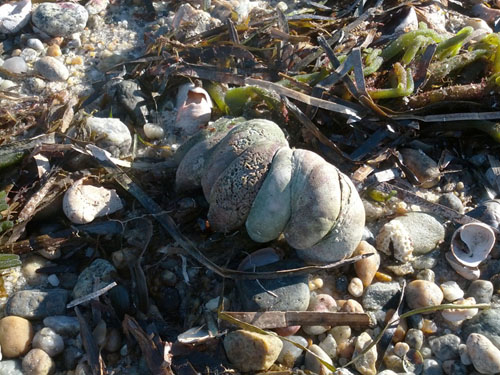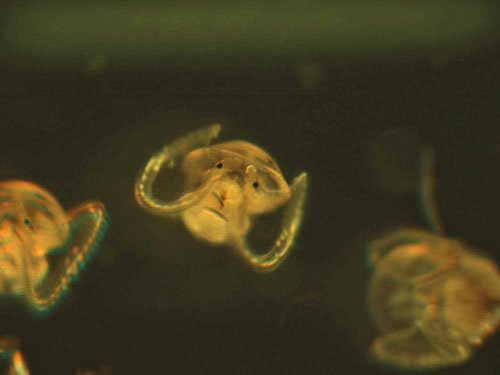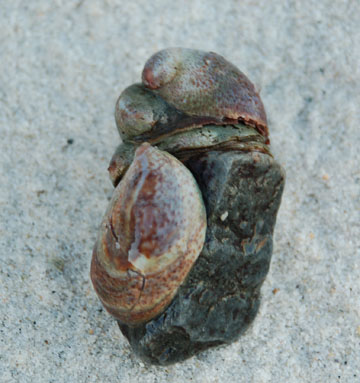Navigation
New Research Reveals The Biomechanics Of How Marine Snails Swim
Equipped with high-speed, high-resolution video, researchers discovered how the larvae of Atlantic slipper limpets, marine snails, swim, a behavior that determines individual dispersal and ultimately, survival.
 Atlantic slipper limpets are common marine snails native to the northeastern U.S. coast.: Photograph by Karen Chan, WHOI courtesy of NSF
Atlantic slipper limpets are common marine snails native to the northeastern U.S. coast.: Photograph by Karen Chan, WHOI courtesy of NSF
Walk the beach or peer into a tidepool anywhere along the northeastern U.S. coast, and you'll find shells stacked on top of one another. They're most likely common Atlantic slipper shells, a species of marine snail.
Scientists took a closer look at these ubiquitous snails, and discovered that how their larvae swim is key to the species' seeming residence in every nook and cranny along the coast. And to how the snails may be able to invade new territory.

Equipped with high-speed, high-resolution video, the researchers discovered how the larvae of these marine snails swim, a behavior that determines individual dispersal and ultimately, survival.
 The vertical optical system that magnifies and records freely swimming microorganisms.: Photograph by Alison Satake, WHOI courtesy of NSF
The vertical optical system that magnifies and records freely swimming microorganisms.: Photograph by Alison Satake, WHOI courtesy of NSF
Researchers at the Woods Hole Oceanographic Institution (WHOI) and Stony Brook University grew Atlantic slipper limpet larvae, which can become slightly larger than a grain of rice, and recorded videos of them swimming.
In previous studies, it was thought that the larvae swim faster when they beat their hair-like cilia faster. However, this new research shows that's not the case.
 Epifluorescent microscopy image of an Atlantic slipper limpet veliger larva.: Photograph by Andreas Hejnol, Sars International Centre for Marine Molecular Biology courtesy of NSF
Epifluorescent microscopy image of an Atlantic slipper limpet veliger larva.: Photograph by Andreas Hejnol, Sars International Centre for Marine Molecular Biology courtesy of NSF
"I was very surprised when I saw that there was no relationship between cilia beat frequency and how fast these animals swim," says Karen Chan, a WHOI scientist and the lead author of a paper published on December 18, 2013 in the journal PLOS ONE.
The larvae control how fast they swim by subtly shifting the position of their velar lobes--flat, disc-shaped wings fringed with cilia.
The ability to make small movements with these velar lobes, akin to how a bird adjusts the angle of its wings while soaring, demonstrates complex neuromuscular control.
"This careful study tells us a lot about how organisms interact with the marine environment, knowledge we need in a time of environmental change," says David Garrison, program director in the National Science Foundation's Division of Ocean Sciences, which funded the research.
The Atlantic slipper shell is a marine snail native to the northeastern United States. It has become an invasive species elsewhere in the world, especially in Europe.
 Microscopy image of Atlantic slipper limpet veliger larvae.: Photograph by Karen Chan, WHOI courtesy of NSF
Microscopy image of Atlantic slipper limpet veliger larvae.: Photograph by Karen Chan, WHOI courtesy of NSF
The slipper shell has many common names, including Atlantic slipper snail, boat shell and quarterdeck shell. It is known in the United Kingdom as the common slipper limpet.
 The Atlantic slipper limpet has become an invasive species in Europe.: Photograph by Alison Satake, WHOI courtesy of NSF
The Atlantic slipper limpet has become an invasive species in Europe.: Photograph by Alison Satake, WHOI courtesy of NSF
The species is a medium-sized sea snail, a marine gastropod mollusk in the family Calyptraeidae, the slipper snails and the cup-and-saucer snails.
Paper co-author Dianna Padilla of Stony Brook University collected the snails from the North Shore of Long Island, N.Y. She grew the larvae in her lab, which were then sent to WHOI for video analysis.
Houshuo Jiang, a scientist at WHOI and collaborator on the project, says the goal is to understand the limpet's role in shaping the marine ecosystem.
With support from NSF, Jiang built a customized, vertically-oriented optical system that can magnify and record high-speed, high-resolution video of microorganisms swimming in seawater at 2,000 frames per second.
"Much more can be observed in great detail using this setup than looking through a microscope," Jiang says.
Jiang found that in a single day, slipper shell larvae could vary their speed from swimming one body length per second to four body lengths per second.
"What this means is they have a lot of control over how fast they swim," Chan says. How they swim can determine where they go.
And where they might turn up next."These results show the flexibility these little animals have," says Padilla, "which is likely what makes them so successful in their environment."
In addition to NSF, the Croucher Foundation, the Royal Swedish Academy of Sciences and WHOI provided support for the project.
This news is from the National Science Foundation (NSF), 18 December 2013. Published on the Horizon International Solutions Site on 21 December 2013.
Related Websites
NSF Award: Collaborative Research: Linking Propulsive Morphology, Swimming Behavior and Sensory Perception by Marine Planktonic Protists to their Trophic Roles within Marine Food Webs:http://www.nsf.gov/awardsearch/showAward?AWD_ID=1129496&HistoricalAwards=false
Search
Latest articles
Agriculture
- World Water Week: Healthy ecosystems essential to human health: from coronavirus to malnutrition Online session Wednesday 24 August 17:00-18:20
- World Water Week: Healthy ecosystems essential to human health: from coronavirus to malnutrition Online session Wednesday 24 August 17:00-18:20
Air Pollution
- "Water and Sanitation-Related Diseases and the Changing Environment: Challenges, Interventions, and Preventive Measures" Volume 2 Is Now Available
- Global Innovation Exchange Co-Created by Horizon International, USAID, Bill and Melinda Gates Foundation and Others
Biodiversity
- It is time for international mobilization against climate change
- World Water Week: Healthy ecosystems essential to human health: from coronavirus to malnutrition Online session Wednesday 24 August 17:00-18:20
Desertification
- World Water Week: Healthy ecosystems essential to human health: from coronavirus to malnutrition Online session Wednesday 24 August 17:00-18:20
- UN Food Systems Summit Receives Over 1,200 Ideas to Help Meet Sustainable Development Goals
Endangered Species
- Mangrove Action Project Collaborates to Restore and Preserve Mangrove Ecosystems
- Coral Research in Palau offers a “Glimmer of Hope”
Energy
- Global Innovation Exchange Co-Created by Horizon International, USAID, Bill and Melinda Gates Foundation and Others
- Wildlife Preservation in Southeast Nova Scotia
Exhibits
- Global Innovation Exchange Co-Created by Horizon International, USAID, Bill and Melinda Gates Foundation and Others
- Coral Reefs
Forests
- NASA Satellites Reveal Major Shifts in Global Freshwater Updated June 2020
- Global Innovation Exchange Co-Created by Horizon International, USAID, Bill and Melinda Gates Foundation and Others
Global Climate Change
- It is time for international mobilization against climate change
- It is time for international mobilization against climate change
Global Health
- World Water Week: Healthy ecosystems essential to human health: from coronavirus to malnutrition Online session Wednesday 24 August 17:00-18:20
- More than 400 schoolgirls, family and teachers rescued from Afghanistan by small coalition
Industry
- "Water and Sanitation-Related Diseases and the Changing Environment: Challenges, Interventions, and Preventive Measures" Volume 2 Is Now Available
- Global Innovation Exchange Co-Created by Horizon International, USAID, Bill and Melinda Gates Foundation and Others
Natural Disaster Relief
- STOP ATTACKS ON HEALTH CARE IN UKRAINE
- Global Innovation Exchange Co-Created by Horizon International, USAID, Bill and Melinda Gates Foundation and Others
News and Special Reports
- World Water Week: Healthy ecosystems essential to human health: from coronavirus to malnutrition Online session Wednesday 24 August 17:00-18:20
- STOP ATTACKS ON HEALTH CARE IN UKRAINE
Oceans, Coral Reefs
- World Water Week: Healthy ecosystems essential to human health: from coronavirus to malnutrition Online session Wednesday 24 August 17:00-18:20
- Mangrove Action Project Collaborates to Restore and Preserve Mangrove Ecosystems
Pollution
- Zakaria Ouedraogo of Burkina Faso Produces Film “Nzoue Fiyen: Water Not Drinkable”
- "Water and Sanitation-Related Diseases and the Changing Environment: Challenges, Interventions, and Preventive Measures" Volume 2 Is Now Available
Population
- "Water and Sanitation-Related Diseases and the Changing Environment: Challenges, Interventions, and Preventive Measures" Volume 2 Is Now Available
- "Water and Sanitation-Related Diseases and the Changing Environment: Challenges, Interventions, and Preventive Measures" Volume 2 Is Now Available
Public Health
- Honouring the visionary behind India’s sanitation revolution
- Honouring the visionary behind India’s sanitation revolution
Rivers
- World Water Week: Healthy ecosystems essential to human health: from coronavirus to malnutrition Online session Wednesday 24 August 17:00-18:20
- Mangrove Action Project Collaborates to Restore and Preserve Mangrove Ecosystems
Sanitation
- Honouring the visionary behind India’s sanitation revolution
- Honouring the visionary behind India’s sanitation revolution
Toxic Chemicals
- "Water and Sanitation-Related Diseases and the Changing Environment: Challenges, Interventions, and Preventive Measures" Volume 2 Is Now Available
- Actions to Prevent Polluted Drinking Water in the United States
Transportation
- "Water and Sanitation-Related Diseases and the Changing Environment: Challenges, Interventions, and Preventive Measures" Volume 2 Is Now Available
- Urbanization Provides Opportunities for Transition to a Green Economy, Says New Report
Waste Management
- Honouring the visionary behind India’s sanitation revolution
- Honouring the visionary behind India’s sanitation revolution
Water
- Honouring the visionary behind India’s sanitation revolution
- Honouring the visionary behind India’s sanitation revolution
Water and Sanitation
- Honouring the visionary behind India’s sanitation revolution
- Honouring the visionary behind India’s sanitation revolution

